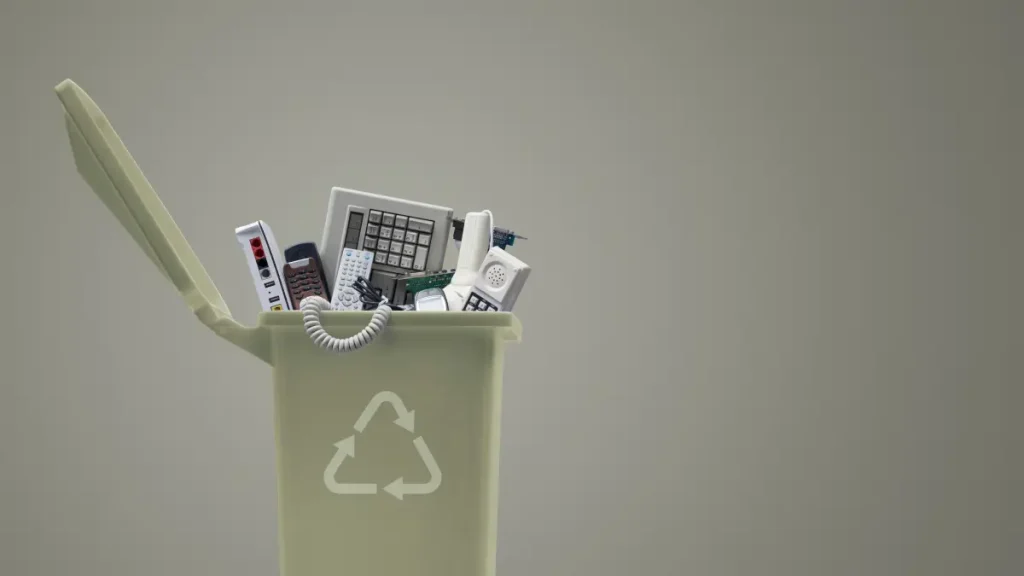
Electronic waste, or e-waste, poses significant environmental and health hazards when improperly discarded. We are surrounded by and literally can’t imagine life without electronics – smartphones, laptops, tablets, TVs, gaming consoles – the list goes on. These devices provide us with endless entertainment, communication, and productivity tools.
But what happens to them when we upgrade or they reach the end of their lifespan? Unfortunately, a significant amount of electronic waste, or e-waste, ends up in landfills, leaching harmful toxins and creating environmental hazards. The good news however is that there are many eco-friendly ways to dispose of your unwanted electronics.
The Growing Problem of E-waste
E-waste is the fastest-growing waste stream globally, according to the International Labour Organization (ILO). A 2022 report by the United Nations University (UNU) estimates that the world generated a staggering 93.1 million metric tonnes of e-waste in 2020, with projections indicating a rise to 120 million metric tonnes by 2050. This rapid growth is fueled by factors such as our ever-increasing reliance on electronic devices, shorter product life spans due to planned obsolescence, and the fast pace of technological advancements.
The improper disposal of e-waste poses serious environmental and health risks. Electronic devices contain hazardous materials like lead, mercury, arsenic, and brominated flame retardants. When dumped in landfills, these toxins can leach into the soil and water, contaminating ecosystems and harming human health. Informal recycling practices in developing countries often involve burning e-waste, releasing harmful air pollutants and exposing workers to dangerous toxins.
Another report by the Global E-waste Statistics Partnership (GESP) revealed that more or less 53.6 million metric tons of e-waste was generated worldwide in 2019 alone, with only 17.4% of it being recycled. This alarming statistic highlights the urgent need for better recycling practices.
Why Recycle Electronics Responsibly?
When electronics are improperly disposed of in landfills, these hazardous materials can leach into the soil and water, posing serious environmental and health risks. Adding to it is the fact that recycling electronics reduces the demand for raw materials, conserves energy, and helps mitigate climate change by reducing greenhouse gas emissions associated with the extraction and processing of virgin materials.
There are numerous compelling reasons to choose responsible e-waste recycling over simply tossing your old electronics in the trash. Here are some key benefits:
- Environmental Protection: Proper e-waste recycling recovers valuable materials like precious metals, plastics, and glass, which can be used to manufacture new products. This reduces the need for virgin resource extraction, minimizing environmental damage from mining and refining processes.
- Conservation of Resources: Recycling e-waste conserves valuable natural resources like copper, gold, and rare earth elements, which are becoming increasingly scarce due to our ever-growing demand for electronics.
- Public Health Benefits: Responsible e-waste recycling prevents hazardous materials from entering our landfills and contaminating our environment. This protects our health and the health of future generations.
- Job Creation: The e-waste recycling industry creates jobs in various sectors, from collection and transportation to material processing and manufacturing.
E-waste Management Best Practices: Reduce, Reuse, Recycle
It’s important to understand the hierarchy of e-waste management, which prioritizes the most environmentally sustainable practices:
- Reduce: The most effective way to manage e-waste is to reduce the amount we generate in the first place. This can be achieved by buying high-quality, durable electronics that are built to last. Research products with longer lifespans and consider purchasing refurbished devices when possible.
- Reuse: If your electronic device is still functional, consider reusing it yourself or donating it to someone who can benefit from it. Many charities, schools, and community centers accept used electronics in good condition. This extends the lifespan of the device and keeps it out of landfills.
- Recycle: When your electronics reach the end of their usable life, responsible recycling is the final option. By choosing certified e-waste recyclers, you can ensure that your devices are dismantled and processed in an environmentally sound manner.
Before sending your electronics off for recycling, it’s crucial to take steps to protect your personal information. Here’s what you need to do:
- Backup Your Data: Make sure to back up all your important data from your device, including photos, documents, and contacts.
- Wipe Your Data: Once you’ve backed up your data, perform a factory reset to completely erase all information from your device. Consult your device’s user manual for specific instructions on data wiping.
- Remove Batteries: If your device has removable batteries, take them out and recycle them separately. Many electronics stores and battery retailers offer battery take-back programs.
Finally, here’s how to recycle electronics and your precious gadgets!
- Research Local Recycling Options: Start by researching local recycling programs and facilities in your area. Many communities have designated drop-off locations or scheduled collection events specifically for e-waste. Websites like earth911 and recyclenation can help you locate recycling centers nearby.
- Manufacturer and Retailer Programs: Many electronics manufacturers and retailers offer take-back programs, allowing consumers to return old devices for recycling. Companies like Apple, Best Buy, and Dell have established recycling initiatives aimed at reducing e-waste and promoting sustainability.
- Donate or Sell: Before recycling, consider donating or selling your old electronics if they are still in working condition. Many charitable organizations accept donations of used electronics, which can be refurbished and repurposed for those in need. Online marketplaces such as eBay, Craigslist, and Facebook Marketplace also provide platforms for selling used gadgets.
- Data Security: Prior to recycling or donating your devices, ensure that all personal data has been securely wiped. Use data erasure software or perform a factory reset to remove any sensitive information stored on the device. Protecting your privacy should be a top priority when disposing of electronics.
- Separate Components: When recycling electronics, separate the various components to facilitate proper recycling. Batteries, circuit boards, plastics, and metals can often be recycled separately to maximize resource recovery.
- e-Stewards: This non-profit organization certifies e-waste recyclers that meet their stringent environmental and social responsibility standards. You can search for e-Stewards certified recyclers in your area on their website.
- Contact Your Local Municipality: Many municipalities have e-waste collection events or designated drop-off locations for residents. Check your local government website or call your sanitation department for details.
- Certified Recyclers: Choose certified recyclers or refurbishers that adhere to responsible recycling practices. Look for certifications such as R2 (Responsible Recycling) or e-Stewards, which ensure that the recycling process meets stringent environmental and ethical standards.
- Education and Awareness: Educate yourself and others about the importance of responsible e-waste disposal. Encourage friends, family, and colleagues to recycle their electronics properly and spread awareness about the environmental consequences of improper disposal.
Important Considerations When Choosing an E-waste Recycler
Here are some additional factors to keep in mind when selecting an e-waste recycler:
- Convenience: Consider factors like location, drop-off hours, and any fees associated with recycling.
- Data Security: Choose a recycler that offers data wiping services or provides clear instructions on how to securely erase your data before recycling.
- Transparency: Look for a recycler that provides information about their recycling process and how they handle hazardous materials.
Recycling for a Sustainable Future
Recycling electronics and gadgets is not only a responsible choice but also a crucial step towards preserving our planet for future generations. Remember, the choices we make today can have a lasting impact on our environment and the well-being of future generations. Let’s all strive to be responsible consumers and dispose of our electronics in a way that protects our planet and its resources.
References:
- Global E-waste Statistics Partnership (GESP):
- Earth911:
- RecycleNation:
- Apple Recycling Program:
- Best Buy Recycling:
- Dell Recycling:
- Facebook Marketplace:
- R2 (Responsible Recycling):
- e-Stewards:
- International Labour Organization (ILO):
- United Nations University (UNU):
- The Basel Convention on the Control of Transboundary Movements of Hazardous Wastes and their Disposal:
- International Labour Organization (ILO), “Global Electronic Waste Monitor 2020: Quantities, flows and the challenges of collection and environmentally sound management,” (2020).
- United Nations University (UNU), “The Global E-waste Monitor 2022,” (2022).
- Environmental Protection Agency (EPA), “Electronic Waste (E-Waste),
- Basel Action Network (BAN), “Toxic Tech: Why Cleaning Up E-waste is Essential,” (2020).
- The World Business Council for Sustainable Development (WBCSD), “Moving Towards a Circular Economy for Electronics – A WBCSD Vision for 2030,” (2019).
- United Nations Environment Programme (UNEP), “Minerals for a Green Future – Strategy for a Sustainable Minerals Economy,” (2016).
Table of Contents



1 comment
[…] For the safety and sustainability of our planet, disposing of e-waste recycling helps in contributing to a greener, breathable Earth for all. […]